Entomopathogenic Fungi against the Red palm weevil, Rhynchophorus ferrugineus Olivier
Samia, A. Yassin , Naglaa, F. Reyad and Abdel-Raheem, M. A
Volume-2, Issue-1, Jan.-Dec., 2025, 2(1): 70-76
INTRODUCTION
The Phoenix dactylifera L., commonly known as date palm, is a diploid perennial plant belonging to the Arecaceae family. It is revered as one of the most ancient and widely cultivated crops in the regions of Southwest Asia and North Africa. Through the course of history, its cultivation has expanded to encompass regions such as Australia, South America, southern Africa, Mexico, Pakistan, and the United States. Rhynchophorus ferrugineus (Olivier), also known as the red palm weevil (RPW), is identified as a destructive insect pest that targets various palm species. Originating in India, this invasive species has proliferated globally and is now widespread across Africa, America, Asia, Europe, and Oceania (Waleed et al., 2024, Wakil et al., 2015, Tagliavia et al., 2014, Fiaboe et al., 2012 and EPPO, 2024). The Red Palm Weevil (RPW) is responsible for extensive harm to coconut trees in the region of Southeast Asia. Rhynchophorus ferrugineus Olivier is known to be the most destructive among pests. Research has been conducted on the pathogens of Rhynchophorus ferrugineus in order to assess their viability as agents for biological control. Metarhizium anisopliae, sourced from R. bilineatus, was discovered subsequent to the treatment of young palm trees against the scarabaeid Scapanes australis using a formulation incorporating M. anisopliae spores (Salama et al., Yassin et al., AgriBio Innovations 2(1): 70-76(2025) 71 2004, Shamseldean, 2004 and Prior and Arura 1985). In Iran, M. anisopliae was obtained from adult insects, while Beauveria bassiana (Bals.) Vuill. was isolated from pupae. It was observed that Beauveria sp. was present in certain cocoons of R. ferrugineus. The effectiveness of using entomopathogenic fungi as biological control agents against various weevil species has been examined. Both adult insects and larvae were successfully infected with B. bassiana and M. anisopliae, leading to mortality rates ranging from 50% to 100% (Ihara et al., 2003, Kehat, 1999 and Abdel-Raheem, 2005). In numerous nations, various authors have utilized Entomopathogenic fungi for biological pest control targeting a range of insect species (Abdel-Raheem, 2013, Sabbour and Abdel-Raheem 2014, Abdel-Rahman and Abdel-Raheem 2018). Specifically, some researchers have employed a variety of isolates, including B. bassiana, M. anisopliae, Isaria fumosorosea, and Verticillum lecanii, against the Rhynchophorus ferrugineus pest. Additionally, other studies have investigated the efficacy of fungal spores and Silver Nano-particles in combatting Rhynchophorus ferrugineus, with findings indicating that Silver Nano-particles demonstrated superior effectiveness across all life stages compared to fungal spores (Abdel-Raheem et al., 2009, 2019, 2020 and Reyad, et al., 2020). Several researchers have leveraged different entomopathogenic fungi in efforts to manage various pests, as documented by (Mohamed Abdel-Raheem, 2015, 2017, 2020, Sabry et. al., 2011, Zaki and Abdel-Raheem 2010, and Sabbour et al., 2012). The aim of this study is to evaluate the effect of the M. anisopliae and B. bassiana against the red palm weevil, R. ferrugineus.
MATERIALS AND METHODS
Entomopathogenic Fungi: Metarhizium anisopliae (Metchinkoff) Soroken isolated from larvae and adults of Scrobipalpa ocellatella and Beauveria bassiana (Balsamo) Vuillemin isolated from Cassida vittata (Abdel-Raheem, 2005) were grown on Peptone media (10g Peptone, 40g Dextrose, 2g yeast extract, 15g Agar and 500 ml. Chloramphenicol). The media was autoclaved at 120 oC for 20 minutes, and poured in Petri-dishes (10 cm diameter x 1.5 cm). Then incubated the fungi and kept at 24 ±2 ̊C and 65± 5 % RH. The fungal isolates were re-cultured every 14 – 30 days and kept at 4 ̊C.
Preparing of concentrations: Spores of fungal isolates harvested by rising with sterilized water 0.5 % Tween 80 from 14 day old culture Peptone media. The suspensions were filtered through cheese cloth to reduce mycelium clumping. The spores were counted in the suspension using a Haemocytometer (0.1 mm × 0.0025 mm2). The concentrations were used 2 × 10⁴, 2×10⁵ and 2 × 10⁶ spore /ml. (C1, C2 & C3).
Insect host: Field observations were recorded on the date palm trees, Phoenix dactylifera L. (Fam. Palmaceae) in Farm Agricultural global production at El-Behira (El-Nubaria) Governorate. A total of 100 palm trees were examined. Many different stages of RPW e.g., larvae, cocoons of coarsely constructed fibers and adults were collected from damaged trunks of infested trees. Samples were collected and transferred weekly to the laboratory and carefully examined.
Insect rearing: A RPW colony was established in the laboratory on sugarcane as both food and oviposition substrate, Adults were set to mate and oviposit in groups of at least five pairs placed on a substrate of moist sugar cane sawdust or on sugar cane logs. From the first larval stage to adult emergence, the RPWs were reared individually at 27-29 °C. For egg harvesting, the adults of both sexes were kept on sugarcane sawdust. Eggs were collected every 2 days.
Bioassay procedure: The Entomopathogenic Fungi, Metarhizium anisopliae Var. acridum (Metchinkoff) Soroken and Beauveria bassiana (Bals.) Vuill. were tested at three concentrations (C1, C2 & C3) to contaminate the larval instar, pupae and adults of the red palm weevil, Rhynchophorus ferrugineus. 100 larvae, pupae and adults were used for each treatment, divided into 4 groups each of 25 larvae, pupae and adults placed in Petri-dishes. One individual / dish, 25 /concentration. The fungi were applied in a suspension containing (C1, C2 & C3) in the control treatment treated with sterilized water and kept at 25 ±2 oC and 70 ±5 % RH. The mortality of all stages of Rhynchophorus ferrugineus was observed daily.
RESULTS
The larvae were infected with M. anisopliae and B. bassiana concentrations 2 × 10⁴, 2 ×10⁵ and 2 × 10⁶ spore /ml., (C1, C2 & C3). The mortality recorded 17.9 % by infection the 3rd concentration from M. anisopliae after 3rd day but was 12.9 % with the same concentration from B. bassiana and day. M. anisopliae was more virulence effect on the larvae of R. ferrugineus than B. bassiana. The mortality reached to 100 % after 9th day from the infection by M. anisopliae but reached to 100% after 10th days from the infection by B. bassiana Fig. 1.
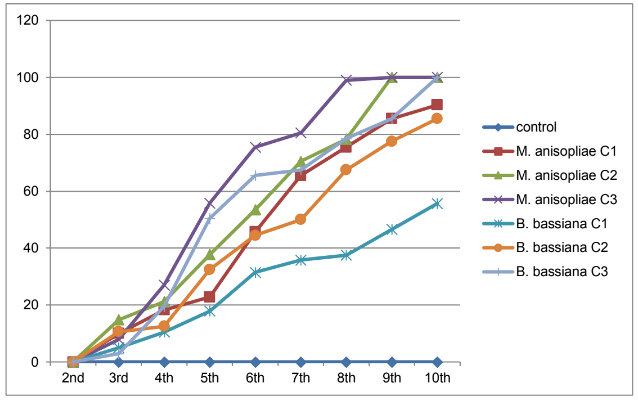
Fig. 1. Percent Mortality of the larvae of Rhynchophorus ferrugineus infected with M. anisopliae and B. bassiana at 25±2 oC and 70 ±5 % RH.
The pupae were infected with M. anisopliae and B. bassiana concentrations 2 × 10 4, 2 ×10 5 and 2 × 10 6 spore /ml., (C1, C2 & C3). The mortality recorded 10.0 % by infection the 3rd concentration from M. anisopliae after 4th day but was 8.0 % with the same concentration and day from B. bassiana. M. anisopliae was more effect on the pupae of R. ferrugineus than B. bassiana. The mortality reached to 100 % after 12th day from the infection by M. anisopliae but reached to 100% after 13th days from the infection by B. bassiana Fig. 2. The adults were infected with M. anisopliae and B. bassiana concentrations (C2 × 10 4, 2 ×10 5 and 2 × 10 6 spore /ml., (C1, C2 & C3).
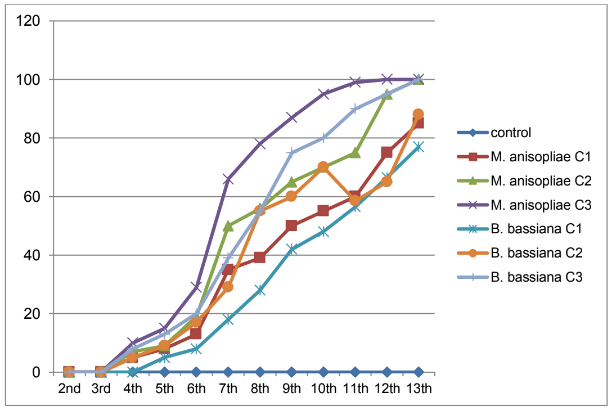
Fig. 2.Percent Mortality of pupae of R. ferrugineus infected with M. anisopliae and B. bassiana at 25 ±2oC and 70 ±5 % RH.
The mortality recorded 4.0 % by infection the 3rd concentration from M. anisopliae after 3rd day but was 0.0 % with the same concentration and day from B. bassiana. M. anisopliae was more effect on the adults of R. ferrugineus than B. bassiana. The mortality reached to 100 % after 10th day from the infection by M. anisopliae but reached to 100% after 13th days from the infection by B. bassiana
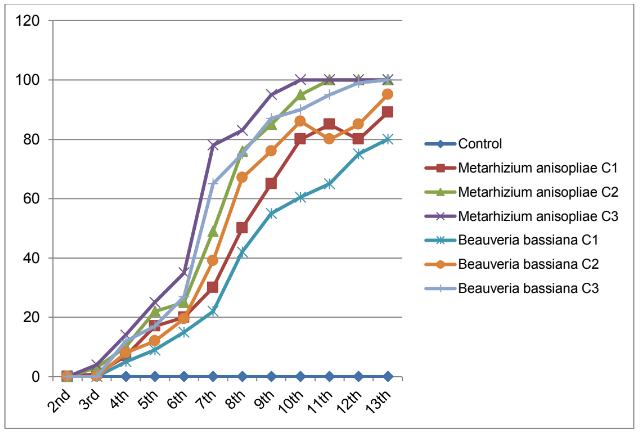
Fig. 3.Percent Mortality of adults of R. ferrugineus infected with M. anisopliae and B. bassiana at 25 ±2oC and 70±5 % RH.
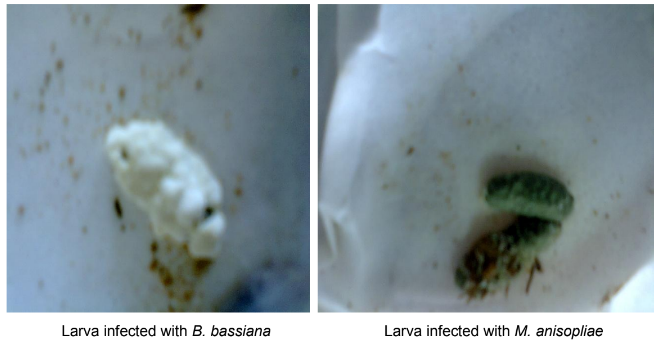
Fig. 4.Larvae of R. ferrugineus infected with B. bassiana and M. anisopliae.
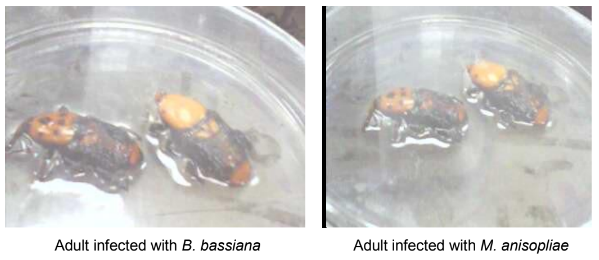
Fig. 5.Adults of R. ferrugineus infected with B. bassiana and M. anisopliae.
DISCUSSION
The data uncovered the potential of M. anisopliae and B. bassiana as effective agents in pest management to mitigate environmental pollution, particularly when pests were below their economic threshold. M. anisopliae showed greater promise than B. bassiana in controlling R. ferrugineus at various stages of its lifecycle, including larvae, pupae, and adults (Glare et al., 2002; Sewify, 2007; Sewify and Fouad 2006). The study demonstrated the significant potential of various EPF isolates in combating specific life stages of R. ferrugineus. Field-based investigations are necessary to evaluate the effectiveness of fungal isolates in varying environmental conditions. It is imperative to examine the effects of temperature, humidity, and persistence post-application of these isolates to determine the optimal conditions for infecting the targeted insect pests. Utilizing these potent fungal isolates could aid in the development of a sustainable integrated management strategy for controlling the red palm weevil in date palm production systems. Exotic fungal isolates that have been previously used to combat various insect pests in different regions have often proven inadequate due to differences in hosts, isolates, and climatic factors. Therefore, in this study, native EPF isolates at different developmental stages of R. ferrugineus were employed, taking into account this limitation. It is crucial to identify highly virulent isolates through laboratory screening bioassays before implementing them in field conditions (Bidochka et al., 1998; Qayyum et al., 2021; Sun, 2016). The results of our screening test demonstrated that all examined isolates exhibited pathogenicity towards R. ferrugineus, corroborating the findings of previous researchers who investigated various isolates of B. bassiana and M. anisopliae. While R. ferrugineus proved to be susceptible to all isolates, variations in virulence were observed among them. This variability in virulence is a commonly observed occurrence, with genetic diversity among isolates from distinct geographical locations being cited as a probable cause. Two of the isolates utilized in the virulence analysis belonged to the species B. bassiana and M. anisopliae. Previous studies have suggested that pathogens obtained from R. ferrugineus display greater virulence towards this invasive pest in comparison to isolates not normally found in the host (Yang et al., 2023, Serna-Domínguez et al., 2019; Qayyum et al., 2021; Ullah et al., 2022; Gindin et al., 2006; Güerri-Agulló et al., 2011; Francardi et al., 2013; Abdel-Raheem, 2011; Abdel-Raheem et al., 2011).
CONCLUSIONS
These data revealed that M. anisopliae and B. bassiana can be used as a promising agent in pest control to reduce the Environmental pollution especially when the pests were under the economic threshold. M. anisopliae was more promising than B. bassiana on (larvae, Pupae, and Adults) R. ferrugineus.
FUTURE SCOPE OF STUDY
This study will allow us in the future to prepare bioactive compounds from entomopathogenic fungi to combat the various stages of the red palm weevil and eliminate it without using pesticides.
REFERENCES
Abdel-Raheem, M. A. (2005). Possibility of Using the Entomopathogenic Fungi Beauveria bassiana and Metarhizium anisopliae for controlling the Sugar- Beet Insects Cassida vittata Vill. and Scrobipalpa ocellatella Boh. in Egypt, Ph.D. Faculty of Agriculture, Cairo University, Cairo.86Pp
Abdel-Raheem, M. A. (2011). Impact of Entomopathogenic Fungi on Cabbage Aphids, Brevicoryne brassica L. in Egypt. Bull. NRC, 36(1), 53-62.
Abdel-Raheem, M. A., Zakia A. Ragab and I. E. Abdel- Rahman. (2011). Effect of Entotomopathogenic Fungi on the Green Stink Bug, Nezara viridula L. in Sugar Beet. Bull. NRC, 36(2), 145-152.
Abdel-Raheem, M. A. (2013). Susceptibility of the red palm weevil, Rhynchophorus ferrugineus Olivier to some Entomopathogenic Fungi. Bull. NRC, 38(1), 69 -82.
Abdel-Rahman, I. E. and Abdel-Raheem, M. A. (2018). Using entomopathogenic fungi as bio agents control on the red palm weevil, Rhynchophorus ferrugineus (Olivier) (Coleoptera: Curculionidae). Journal of Entomology and Zoology Studies, 6(6), 387-390.
Abdel-Raheem M. A., Huda A. ALghamdi, Naglaa F. Reyad (2019). Virulence of Fungal Spores and Silver Nano-particles from Entomopathogenic Fungi on the Red Palm Weevil, Rhynchophorus ferrugineus Olivier (Coleoptera: Curculionidae). Egyptian Journal of Biological Pest Control, 2019, 29(1), 97.
Abdel-Raheem, M.A., Ismail, I.A., Abdel-Rahman, R. S., Abdel-Rhman, I. E. and Naglaa F. Reyad. (2015). Efficacy of Three Entomopathogenic Fungi on Tomato leaf miner, Tuta absoluta in Tomato crop in Egypt. Swift journals of Agricultural Research, 1(2), 015-020.
Abdel-Raheem, M.A.; and Lamya Ahmed Al-Keridis. A. (2017). Virulence of three Entomopathogenic Fungi against White fly, Bemisia tabaci (Genn.) (Hemiptera: Aleyrodidae) in Tomato Crop. Journal of Entomology, 14(4), 155-159.
Abdel-Raheem, M. A., K.H.Sabry and Zakia A.Ragab. (2009). Effect of different fertilization rates on control of Bemisia tabaci (Genn.) by Virticillium lecanii and Beauveria bassiana in potato crop. J. Biol. Pest control, 19(2), 129-133.
Abdel-Raheem M. A.; Naglaa F. Reyad, and Huda A. Alghamdi (2020). Virulence of Nano – Particle preparation of Entomopathogenic fungi and Entomopathogenic Bacteria against red palm weevil, Rhynchophorus ferrugineus (Olivier) (Coleoptera: Curculionidae). Romanian Biotechnological Letters, 25(1), 1151-1159.
Bidochka, M. J., Kasperski, J. E., Wild, G. A. M. (1998). Occurrence of the entomopathogenic fungi Metarhizium anisopliae and Beauveria bassiana in soils from temperate and near- northern habitats. Can. J. Bot. 1998, 76, 1198– 1204.
EPPO (European and Mediterranean Plant Protection Organization). Rhynchophorus ferrugineus. EPPO Global Data Base. Available online: https://gd.eppo.int/taxon/RHYCFE/distribution (accessed on 25 February 2024).
Fiaboe, K.K.M.; Peterson, A.T.; Kairo, M.T.K.; Roda, A.L. (2012). Predicting the potential worldwide distribution of the red palm weevil Rhynchophorus ferrugineus (Olivier) (Coleoptera: Curculionidae) using ecological niche modeling. Fla. Entomol., 95, 659–673.
Francardi, V., Benvenuti, C., Barzanti, G. P., Roversi, P. F. (2013). Autocontamination trap with entomopathogenic fungi: A possible strategy in the control of Rhynchophorus ferrugineus (Olivier, 1790) (Coleoptera, Curculionidae). Redia 2013, 96, 57–67.
Gindin, G., Levski, S., Glazer, I., Soroker, V. (2006). Evaluation of the entomopathogenic fungi Metarhizium anisopliae and Beauveria bassiana against the red palm weevil Rhynchophorus ferrugineus. Phytoparasitica. 2006, 34, 370–379.
Glare T. R., Placet, C., Nelson, T. L. and Reay, S. D. (2002). Potential of Beauveria and Metarhizium as control agents of pinhole borers (Platypus spp.): 73-79.
Güerri-Agulló, B., López-Follana, R., Asensio, L., Barranco, P., Lopez-Llorca, L.V. (2011). Use of a solid formulation of Beauveria bassiana for biocontrol of the red palm weevil (Rhynchophorus ferrugineus) (Coleoptera: Dryophthoridae) under field conditions in SE Spain. Fla. Entomol., 94, 737–747.
Ihara, F., Toyama, M. and Sato, T. (2003). Pathogenicity of Metarhizium anisopliae to the chestnut weevil larvae under laboratory and field conditions. Appl. Entomol. Zool. 38, 461-465.
Kehat, M. (1999). Threat to date palms in Israel, Jordan and the Palestinian Authority by the red palm weevil, Rhynchophorus ferrugineus. Phytoparasitica, 27, 241-242.
Mohamed Abdel-Raheem (2020). Cottage Industry of Biocontrol Agents and Their Applications, Chapter: 7, Isolation, Mass Production and Application of Entomopathogenic Fungi for Insect Pests Control, Pp. 231-251.
Prior, C. and Arura, M. (1985). The infectivity of Metarhizium anisopliae to two insect pests of coconuts. J. Invertebr. Pathol., 45, 187-194.
Qayyum, M.A.; Bilal, H.; Ali, H.; Raza, H.; Wajid, M. (2021). Factors affecting the epizootics of entomopathogenic fungi—A review. J. Bioresour. Manag. 2021, 8, 78–85.
Qayyum, M.A.; Saeed, S.; Wakil, W.; Nawaz, A.; Iqbal, N.; Yasin, M.; Alamri, S. (2021). Diversity and correlation of entomopathogenic and associated fungi with soil factors. J. King Saud Univ. Sci., 33, 101520.
Reyad, N. F., Al-Ghamdi, H. A., Abdel-Raheem, M. A., Al-Shaeri, M. A.(2020). The effects of botanical oils on the red palm weevil, Rhynchophorus ferrugineus olivier (Coleoptera: Curculionidae), Applied Ecology and Environmental Research, 2020, 18(2), pp. 2909- 2919.
Sabbour, M.M. and M.A. Abdel-Raheem (2014). Evaluations of Isaria fumosorosea Isolates against the Red Palm Weevil Rhynchophorus ferrugineus under Laboratory and Field Conditions. Current Science International, 3(3), 179-185.
Sabbour, M.M., A. Abd El–Rahman, M.A. Abdel-Raheem and M. Ragei (2012). Pathogenicity of Entomopathogenic Fungi Against Olive Insect Pests Under Laboratoryand Field Conditions in Egypt. Journal of Applied Sciences Research, 8(7), 3448-3452.
Sabry, K. H., M. A. Abdel-Raheem and Monira M. El- Fatih. (2011). Efficacy of the Entotomopathogenic Fungi, Beauveria bassiana and Metarhizium anisopliae on some pests under Laboratory Conditions. J. Biol. Pest control, 21(1), 33-38
Salama, H.S., Foda, M.S., El-Bendary, M.A. and Abdel- Razek, A. (2004). Infection of red palm weevil, Rhynchophorus ferrugineus, by spore-forming bacilli indigenous toits natural habitat in Egypt. J. Pestic. Sci., 77, 27-31.
Serna-Domínguez, M. G., Andrade-Michel, G. Y., Rosas- Valdez, R., Castro-Félix, P., Arredondo-Bernal, H. C., Gallou, A. (2019). High genetic diversity of the entomopathogenic fungus Beauveria bassiana in Colima, Mexico. J. Invertebr. Pathol., 163, 67–74.
Sewify , G.H., (2007). The use entomopathogenic fungus Beauveria bassiana for the control of the red palm weevil. The Symosium on date palm, Saudi Arabia, King Faisal Uni., Al Ahssa.
Sewify, G.H. and S.H. Fouad (2006). Integrated control of red palm weevil Rhynchophorus ferrugineus (coleopteran: Curculionidea). Agric. Sci. Mansoura Uni., 31(4), 2415-2426.
Shamseldean, M.M. (2004). Laboratory trials and field applications of Egyptian and foreign entomopathogenic nematodes used against the red palm weevil, Rhynchophorus ferrugineus Oliv. Int. J. Nematol., 14, 44-55.
Sun, X., Yan, W., Qin, W., Zhang, J., Niu, X., Ma, G.; Li, F. (2016). Screening of tropical isolates of Metarhizium anisopliae for virulence to the red palm weevil Rhynchophorus ferrugineus Olivier (Coleoptera: Curculionidae). Springer Plus 2016, 5, 1100.
Tagliavia, M.; Messina, E.; Manachini, B.; Cappello, S.; Quatrini, P. (2014). The gut microbiota of larvae of Rhynchophorus ferrugineus Oliver (Coleoptera: Curculionidae). BMC Microbiol., 14, 136.
Ullah, S.; Raza, M., Alkafafy, M., Sayed, S., Hamid, M. I., Majeed, M. Z., Riaz, M. A., Gaber, N. M. and Asim, M. (2022). Isolation, identification and virulence of indigenous entomopathogenic fungal strains against the peach-potato aphid, Myzus persicae Sulzer (Hemiptera: Aphididae), and the fall armyworm, Spodoptera frugiperda (J.E. Smith) (Lepidoptera: Noctuidae). Egypt. J. Biol. Pest Control. 2022, 32, 1–11.
Wakil, W., Faleiro, J. R., Miller, T. A., Bedford, G.O., Krueger, R. R. (2015). Date palm production and pest management challenges. In Sustainable Pest Management in Date Palm: Current Status and Emerging Challenges, Sustainability in Plant and Crop Protection; Wakil, W., Faleiro, J.R., Miller, T.A., Eds.; Springer International Publishing: Cham, Switzerland; pp. 1–11.
Waleed S. Alwaneen, Waqas Wakil, Nickolas G. Kavallieratos, Mirza Abdul Qayyum, Muhammad Tahir, Khawaja G. Rasool, Mureed Husain, Abdulrahman S. Aldawood and, David Shapiro- Ilan (2024). Efficacy and Persistence of Entomopathogenic Fungi against Rhynchophorus ferrugineus on Date Palm: Host to Host Transmission, Agronomy, Agronomy, 14(4), 642.
Yang, T. H., Wu, L. H., Liao, C. T., Li, D., Shin, T. Y., Kim, J. S., Nai, Y. S. (2023). Entomopathogenic fungi-mediated biological control of the red palm weevil Rhynchophorus ferrugineus. J. Asia-Pac. Entomol. 2023, 26, 102037.
Zaki, F. N. and Abdel-Raheem, M. A. (2010). Using of Entomopathogenic fungi and insecticide against some insect pests attacking peanuts and sugar beet. Archives of phytopathology and plant protection, 43(18), 1819-1828.
How to cite this article:
Samia, A. Yassin, Naglaa, F. Reyad and Abdel-Raheem, M. A. (2025). Entomopathogenic Fungi against the Red palm weevil, Rhynchophorus ferrugineus Olivier. AgriBio Innovations, 2(1): 70-76.